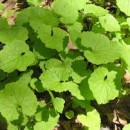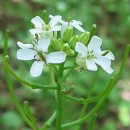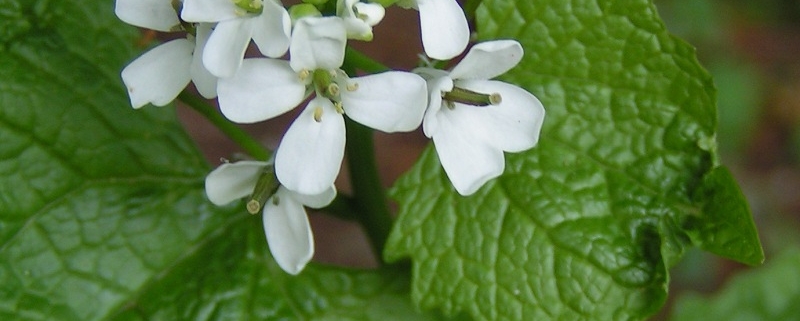Garlic Mustard Abatement Project
 There’s a noxious weed that is invading Hood River County and the SWCD is working hard to stop it in its tracks and need your help! First thing is first, what is garlic mustard and how can you identify it? Garlic mustard (Alliaria petiolata) is a cool season biennial herb with stalked, triangular to heart-shaped, coarsely toothed leaves that give off an odor of garlic when crushed. First-year plants appear as a rosette of green leaves close to the ground (garlic mustard in the rosette stage can look similar to violets).
There’s a noxious weed that is invading Hood River County and the SWCD is working hard to stop it in its tracks and need your help! First thing is first, what is garlic mustard and how can you identify it? Garlic mustard (Alliaria petiolata) is a cool season biennial herb with stalked, triangular to heart-shaped, coarsely toothed leaves that give off an odor of garlic when crushed. First-year plants appear as a rosette of green leaves close to the ground (garlic mustard in the rosette stage can look similar to violets).  Rosettes remain green through the winter and develop into mature flowering plants the following spring. (*NOTE – Although it is called a biennial (meaning a plant lives out its complete life cycle in two years), we are noticing that many first-year plants are able to produce a flower and seed!) Flowering plants of garlic mustard reach from 2 to 3-½ feet in height and produce clusters of small white flowers, each with four petals in the shape of a cross.
Rosettes remain green through the winter and develop into mature flowering plants the following spring. (*NOTE – Although it is called a biennial (meaning a plant lives out its complete life cycle in two years), we are noticing that many first-year plants are able to produce a flower and seed!) Flowering plants of garlic mustard reach from 2 to 3-½ feet in height and produce clusters of small white flowers, each with four petals in the shape of a cross.  Seed pods form mid-summer and are in the form of a green capsule called a silique. Seeds are small black grow in a row inside the silique. An individual plant can produce up to 868 seeds.
Seed pods form mid-summer and are in the form of a green capsule called a silique. Seeds are small black grow in a row inside the silique. An individual plant can produce up to 868 seeds.  The capsules burst open when mature and disperse seeds up to several meters. Seeds have been observed to remain viable in the soils for at least 5 years, but likely can regenerate after longer. Seeds are easily dispersed by mechanical equipment, cars, tread on shoes, dogs, large game, and burrowing animals. It can also spread by water in riparian areas. Garlic mustard will readily establish in disturbed areas.
The capsules burst open when mature and disperse seeds up to several meters. Seeds have been observed to remain viable in the soils for at least 5 years, but likely can regenerate after longer. Seeds are easily dispersed by mechanical equipment, cars, tread on shoes, dogs, large game, and burrowing animals. It can also spread by water in riparian areas. Garlic mustard will readily establish in disturbed areas.
Now that you know what the plant looks like and some of its key features; why do we care? Garlic mustard is a noxious weed, originally brought over as a culinary herb from Europe. Garlic mustard is designated as both a “B” and “T” weed by the Oregon Department of Agriculture. Garlic mustard has the capability to thrive in all conditions. It can grow in sun or shade, wet or dry, forested or open landscapes. It reproduces prolifically and has the ability to become the dominate species in any ecosystem.  The Columbia River Gorge is home to many unique and diverse plant communities as well as the animal communities that depend on these plants. Garlic mustard threatens the diversity and survival of these ecosystems. Garlic mustard has the ability to change the composition of the soil making the conditions more suitable for garlic mustard and difficult for under story plants or young trees to grow. We do not know what the extent of the impacts a garlic mustard infestation would have on commercial agriculture or forestry. Imagine going on your favorite wildflower hike in the spring time only to find a stand of garlic mustard…
The Columbia River Gorge is home to many unique and diverse plant communities as well as the animal communities that depend on these plants. Garlic mustard threatens the diversity and survival of these ecosystems. Garlic mustard has the ability to change the composition of the soil making the conditions more suitable for garlic mustard and difficult for under story plants or young trees to grow. We do not know what the extent of the impacts a garlic mustard infestation would have on commercial agriculture or forestry. Imagine going on your favorite wildflower hike in the spring time only to find a stand of garlic mustard…
There are only two known sites of this noxious invader in Hood River County located in Parkdale. The Hood River SWCD received a grant from the Oregon State Weed Board for a fifth year of control work at these two upper valley sites. In cooperation with the Oregon Department of Agriculture, United States Forest Service, Hood River County, private landowners and other partnering organizations belonging to the Columbia Gorge Cooperative Weed Management Area (CWMA), we are using an integrated pest management approach to control the pest. We are using manual (hand-pulling), chemical (herbicide) and cultural (mulch) practices to continue the control efforts that were initiated in 2011.



